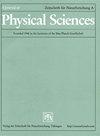The transmittance properties of the one-dimensional gyroidal superconductor photonic crystals
IF 1.3
4区 物理与天体物理
Q4 CHEMISTRY, PHYSICAL
Zeitschrift Fur Naturforschung Section A-A Journal of Physical Sciences
Pub Date : 2023-10-09
DOI:10.1515/zna-2023-0179
引用次数: 0
Abstract
Abstract In this study, the transfer matrix method is used to analyze the optical properties of a layered structure, {Air(SrTiO 3 /BSCCO) 20 Substrate}, consisting of air, SrTiO 3 , BSCCO (bismuth strontium calcium copper oxide) bilayers, and a substrate. This paper aims to investigate the transmittance spectra of two proposed one-dimensional (1D) structures, including a conventional superconductor photonic crystal (PC) and a gyroidal superconductor PC at infrared (IR) wavelengths. A comprehensive analysis has been carried out to provide useful insights into the optical properties and the behavior of the proposed structure, highlighting the impact of many parameters, such as refractive index, filling fraction, and layer thickness. The numerical findings showed that the permittivity of the BSCCO superconductor of a gyroidal geometry takes a different response compared to the conventional one. Notably, the filling fraction and refractive index of the host material have a significant control on both real and imaginary parts of the gyroidal BSCCO permittivity through the considered wavelengths. Thus, the proposed design provides high transmittivity outside the obtained photonic band gap compared to the conventional one. We believe that the designed one-dimensional gyroidal BSCCO photonic crystals could act as an efficient reflector through near IR for optoelectronics and energy applications.一维陀螺超导体光子晶体的透射特性
摘要本研究采用传递矩阵法分析了由空气、srtio3、BSCCO(铋锶钙氧化铜)双层和衬底组成的层状结构{Air(srtio3 /BSCCO) 20 Substrate}的光学性质。本文旨在研究两种一维(1D)结构,包括传统超导体光子晶体(PC)和陀螺超导体光子晶体(PC)在红外(IR)波长的透射光谱。我们进行了全面的分析,以提供有用的见解,以了解所提出的结构的光学性质和行为,突出了许多参数的影响,如折射率,填充分数和层厚度。数值计算结果表明,陀螺几何形状的BSCCO超导体的介电常数与常规超导体的介电常数具有不同的响应。值得注意的是,通过所考虑的波长,填充分数和主体材料的折射率对陀螺BSCCO介电常数的实部和虚部都有显著的控制。因此,与传统设计相比,所提出的设计在获得的光子带隙外提供了高透射率。我们相信所设计的一维陀螺仪BSCCO光子晶体可以作为一种有效的近红外反射器,用于光电子学和能源应用。
本文章由计算机程序翻译,如有差异,请以英文原文为准。
求助全文
约1分钟内获得全文
求助全文
来源期刊
CiteScore
3.00
自引率
5.60%
发文量
81
审稿时长
3.3 months
期刊介绍:
A Journal of Physical Sciences: Zeitschrift für Naturforschung A (ZNA) is an international scientific journal which publishes original research papers from all areas of experimental and theoretical physics. Authors are encouraged to pay particular attention to a clear exposition of their respective subject, addressing a wide readership. In accordance with the name of our journal, which means “Journal for Natural Sciences”, manuscripts submitted to ZNA should have a tangible connection to actual physical phenomena. In particular, we welcome experiment-oriented contributions.

 求助内容:
求助内容: 应助结果提醒方式:
应助结果提醒方式:


